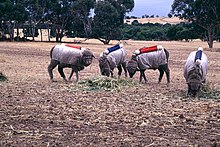Enteric fermentation

Enteric fermentation is a digestive process by which carbohydrates are broken down by microorganisms into simple molecules for absorption into the bloodstream of an animal. Because of human agricultural reliance in many parts of the world on animals which digest by enteric fermentation, it is one of the factors in increased methane emissions.
Ruminants[]
Ruminant animals are those that have a rumen. A rumen is a multichambered stomach found almost exclusively among some artiodactyl mammals, such cattle, deer, and camels, enabling them to eat cellulose-enhanced tough plants and grains that monogastric (i.e., "single-chambered stomached") animals, such as humans, dogs, and cats, cannot digest.
Enteric fermentation occurs when methane (CH4) is produced in the rumen as microbial fermentation takes place. Over 200 species of microorganisms are present in the rumen, although only about 10% of these play an important role in digestion. Most of the CH4 byproduct is belched by the animal, however, a small percentage of CH4 is also produced in the large intestine and passed out as flatulence.
Methane emissions are an important contribution to global greenhouse gas emissions. The IPCC reports that methane is more than twenty times as effective as CO2 at trapping heat in the atmosphere - though note that it is produced in substantially smaller amounts. Methane represents also a significant energy loss to the animal ranging from 2 to 12% of gross energy intake.[1] So, decreasing the production of enteric CH4 from ruminants without altering animal production is desirable both as a strategy to reduce global greenhouse gas emissions and as a means of improving feed conversion efficiency.[2] In Australia ruminant animals account for over half of their green house gas contribution from methane.[3] Australia has implemented a voluntary immunization program for cattle in order to help reduce flatulence-produced CH4.[citation needed]
However, in Australia there are ruminant species of the kangaroos that are able to produce 80% less methane than cows. This is because the gut microbiota of Macropodids, rumen and others parts of their digestive system, is dominated by bacteria of the family Succinivibrionaceae. These bacteria are able to produce succinate as a final product of the , producing small amounts of methane as end product. Its special metabolic route allows it to utilize other proton acceptors, avoiding the formation of methane.[4]
Experimental management[]
Enteric fermentation was the second largest anthropogenic source of methane emissions in the United States from 2000 through 2009.[5] In 2007, methane emissions from enteric fermentation were 2.3% of net greenhouse gases produced in the United States at 139 teragrams of carbon dioxide equivalents (Tg CO2) out of a total net emission of 6087.5 Tg CO2.[6] For this reason, scientists believe that, with the aid of microbial engineering, the use of microbioma to modify natural or anthropogenic processes, we could change the microbiota composition of the rumen of strong methane producers, emulating the Macropodidae microbiota.
Recent studies claim that this technique is possible to perform. In one of these studies scientists analyze the changes of human microbiota by different alimentary changes.[7] In other study, researchers introduce a human microbiota in gnotobiotic mice in order to compare the different changes for developing new ways to manipulate the properties of the microbiota so as to prevent or treat various diseases.[8]
Asparagopsis taxiformis is a species of algae that has shown to substantially reduce methane emissions in vitro studies. However, there is no evidence in vivo.[9]
See also[]
- Environmental impact of meat production#Greenhouse gas emissions
- Atmospheric methane
References[]
- ^ Johnson, K A; Johnson, D E (2016-08-01). "Methane emissions from cattle". Journal of Animal Science. 73 (8): 2483–2492. doi:10.2527/1995.7382483x. ISSN 0021-8812. PMID 8567486. Archived from the original on 2017-08-29. Retrieved 2019-03-17.
- ^ Martin, C.; Morgavi, D. P.; Doreau, M. (2010-03-01). "Methane mitigation in ruminants: from microbe to the farm scale". Animal. 4 (3): 351–365. doi:10.1017/S1751731109990620. ISSN 1751-732X. PMID 22443940.
- ^ Australian Greenhouse Office, "National Greenhouse Gas Inventory", Canberra ACT, March 2007.
- ^ Isolation of Succinivibrionaceae Implicated in Low Methane Emissions from Tammar Wallabies P. B. Pope, Science 333, 646 (2011)
- ^ Executive Summary - Inventory of U.S. Greenhouse Gas Emissions and Sinks: 1990-2009 - U.S. Environmental Protection Agency, April, 2011; available at: http://www.epa.gov/climatechange/emissions/downloads11/US-GHG-Inventory-2011-Executive-Summary.pdf Archived 2011-08-16 at the Wayback Machine
- ^ Inventory of U.S. Greenhouse Gas Emissions and Sinks: 1990-2007 - U.S. Environmental Protection Agency, April, 2009; available at: http://www.epa.gov/climatechange/emissions/downloads09/ExecutiveSummary.pdf Archived 2009-11-03 at the Wayback Machine
- ^ Wu, Gary D.; et al. (2011). "Linking Long-Term Dietary Patterns with Gut Microbial Enterotypes". Science. 334 (6052): 105–108. Bibcode:2011Sci...334..105W. doi:10.1126/science.1208344. PMC 3368382. PMID 21885731.
- ^ Faith, Jeremiah J. (2011). "Predicting a Human Gut Microbiota's Response to Diet in Gnotobiotic Mice". Science. 334 (6038): 101–104. Bibcode:2011Sci...333..101F. doi:10.1126/science.1206025. PMC 3303606. PMID 21596954.
- ^ Kinley, Robert D.; Nys, Rocky de; Vucko, Matthew J.; Machado, Lorenna; Tomkins, Nigel W. (9 February 2016). "The red macroalgae Asparagopsis taxiformis is a potent natural antimethanogenic that reduces methane production during in vitro fermentation with rumen fluid". Animal Production Science. 56 (3): 282–289. doi:10.1071/AN15576. Archived from the original on 2018-07-02. Retrieved 2019-03-17.
Un-cited references[]
- M. J. Gibbs and R. A. Leng, "Methane Emissions From Livestock", Methane And Nitrous Oxide, Proceedings Of The International IPCC Workshop, Amersfoort, The Netherlands, pp. 73–79, February 1993.
- State Workbook: Methodology For Estimating Greenhouse Gas Emissions, EPA 230-B-92-002, U. S. Environmental Protection Agency, Office of Policy, Planning and Evaluation, Washington, DC, 1995.
- International Anthropogenic Methane Emissions: Estimates for 1990, EPA-230-R-93-010. U. S. Environmental Protection Agency, Global Change Division, Office of Air and Radiation, Washington, DC, 1994.
- P. Crutzen, et al., Methane Production By Domestic Animals, Wild Ruminants, Other Herbivorous Fauna, and Humans, Tellus, 38B(3-4): 271–284, 1986.
- Anthropogenic Methane Emissions In The United States: Estimates For 1990, Report to Congress, U. S. Environmental Protection Agency, Office of Air and Radiation, Washington, DC, 1993.
- Greenhouse Gas Inventory Workbook, Intergovernmental Panel On Climate Change/Organization For Economic Cooperation And Development, Paris, France, pp. 4.1-4.5, 1995.
- Animal physiology
- Climate change and agriculture